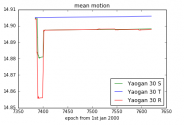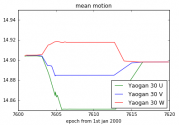There is no dedicated AShBM So I will put it here China has completed the Yaogan series of surveillance satellite network according to Henri K It was decades long effort Nowhere to hide for CVBG. Another thing China has experimented with socalled agile satellite who can change their orbit. Now where is our friend SEAD who said china need thousand of satellite to cover certain area. Or China DOES Not has the necessary surveillance system?. The original is in French so Google translation is here
The Yaogan-30 constellation has already been the subject of two , but this should be the last: following the launch of the seventh trio of satellites, the constellation now has six evenly distributed orbital planes. She has thus reached her full capacity and final form.
The six orbital planes of the constellation
Having only six orbital planes with seven launches might seem odd. As pointed out in a , the third and fourth launches injected their satellites into the same orbital plane, and created a "train" of five satellites that follow each other very closely. This makes it possible to have an extremely high revisit rate when this train passes over a region of interest.
A satellite out of service
The other peculiarity of the constellation is that one of the satellites of the sixth group is out of service, or at least its propulsion system is: Yaogan 30T (international designator 2020-021C) is not correctly positioned in its orbital plane. Normally the three satellites in the same plane are phased at 120° from each other, to maximize constellation coverage. On the other hand, Yaogan 30T and 30S are currently very close to each other, which makes one of the two redundant.
The one with the problem is Yaogan 30T, as can be seen in this graph comparing the sixth group's orbital elements:
View attachment 88381
Evolution over time of the number of revolutions per day for the 6th group
The 30T satellite has not made any maneuvers since it has been in orbit, and therefore performs more revolutions per day around the Earth than the other two. This means that its position in the orbital plane is constantly changing, and the fact that it is currently near 30S is just a coincidence. He will move away from it over time.
We can compare with what happens in the case of a group whose three satellites are perfectly functional, as is the case for the last launch:
View attachment 88382
Evolution over time of the number of revolutions per day for the 7th group
The satellites were launched together and therefore at the beginning the curves are confused. Then they used their thrusters to maneuver and each had a different number of revolutions per day. This allowed them to position themselves on a different sector of the orbit. They let this position drift until the 120° phase between the satellites was reached, then froze their orbital configuration by maneuvering again so that they all had exactly the same number of revolutions per day. This ensures that they stay synchronized in their orbit.
It is possible that China will eventually replace the satellite that is out of order, because it would improve the coverage offered by the constellation, making it more regular with fewer interruptions. This would be a good opportunity for one of China's new small launchers like the CZ-11 rocket, since a single Yaogan-30 type satellite represents a small payload.
Cover
Speaking of coverage, let's look at what the constellation can do. Given its inclination, it is optimized for observing the environment close to China, in particular the approaches to its Pacific coast. Taipei, the capital of Taiwan, is therefore a very representative area of interest, especially since the recent rearmament efforts of the Republic of China with the United States have heightened tensions in the region.
Based on the 3D models of the satellites broadcast by Chinese television, they do not appear to carry radar or imaging systems, so they are probably used for electronic intelligence, with perhaps a communication function as well. This kind of sensors generally need to see their target under an angle of incidence of at least 5°. Based on this assumption, we can calculate the coverage of Taipei over a 24-hour period:
View attachment 88383
In cyan, the coverage periods.
We see that the coverage is almost constant, with the longest interruption lasting around 30 minutes, and most interruptions lasting 10 minutes every half hour. The following video shows satellite positions and coverage opportunities (in the form of a purple link between the satellite and the ground):
Plans for the future
This rate of revisiting is already the highest among all known constellations in China or elsewhere, but the middle country does not intend to stop there, as Academician Li Deren explains in a
:
“The first step is to provide local (local) coverage from the South China Sea to the North China region . This requires about 20 remote sensing satellites and 1-3 communications satellites in geostationary orbit to achieve 15 minute temporal resolution. High-resolution target images and sub-meter navigation and positioning accuracy are sent to users' mobile phones and other intelligent terminals;
The second stage is the regional coverage of China and neighboring countries along the Belt and Road. This requires a hundred remote sensing satellites. Among them, half of the remote sensing satellites are optical satellites and the other half are radar satellites to guarantee the broadcasting of images day and night, plus 150 communication satellites;
The third step is global . To achieve a worldwide service, it is estimated that 200 remote sensing satellites and 300 communication satellites will be required. The service index is the time resolution of 5 minutes, that is, the required image target is found within 5 minutes, the resolution and navigation accuracy reach 0.5 m, and the time processing and communication in orbit is less than 1 minute before being delivered to the user's mobile phone. »
Yaogan-30 is the first stage, with 21 satellites optimized for the Chinese coastline. However, it does not reach a revisit every 15 minutes, so Mr. Deren may be talking about another constellation that will be launched in the near future. The use of geostationary satellites as relays, so as to minimize the latency of the system, can on the other hand already be implemented on Yaogan-30.
Li Deren also explains that future developments will combine the traditionally separate functions of communication, Earth observation and positioning into a single system, and data will be sent directly to end-users' phones to minimize latency and maximize their impact:
" The perceived data will be intelligently processed to provide users with the function of PNTRC, P representing the position, N the navigation route, T the time, R the image remote sensing [Remote sensing], and C the communication, it that is, this information can be sent to the receiving device in your hand. "
This plan looks like two drops of water to American ambitions to acquire a multi-layered military constellation to ensure communications, anti-ballistic missile warning and Earth observation. Given the extent of Chinese investment in the field, there is no doubt that they will manage to develop an equivalent system, and that therefore we have not finished hearing about large constellations of Chinese satellites.



